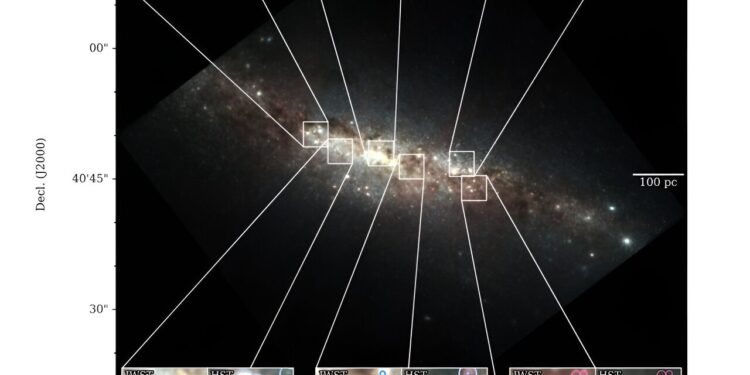The central 870 pc of the Cigar Galaxy observed with NIRCam. Credit: Levy et al., 2024.
By analyzing images obtained with the James Webb Space Telescope (JWST), an international team of astronomers has managed to identify more than 1,000 new candidate star clusters in the Cigar Galaxy. This discovery was reported in a research paper published on August 8 on the preprint server arXiv.
The Cigar Galaxy (also known as Messier 82, M 82, or NGC 3034) is a small, irregularly-forming galaxy located about 11.73 million light-years away in the constellation Ursa Major. It is about 40,800 light-years across and has a dynamical mass of about 10 billion solar masses. It is one of the closest star-forming galaxies to Earth.
Previous observations of the Cigar Galaxy have identified 260 star clusters within 3,000 light-years of the galaxy’s center and 363 star clusters outside this central region.
A group of astronomers led by Rebecca C. Levy of the Stewart Observatory in Tucson, Arizona, used the JWST Near Infrared Camera (NIRCam) to obtain a more precise census of star cluster populations in the Cigar Galaxy. NIRCam allowed them to detect, catalog, and analyze new candidate star clusters emitting in the near-infrared.
“In this letter, we construct and present the JWST NIRCam star cluster catalog in the central region of the M82 starburst,” the researchers wrote.
In total, Levy’s team initially identified 2,472 candidate star clusters in the Cigar Galaxy. Upon further analysis, nearly half of these were considered stray sources, leaving 1,357 candidate star clusters with masses of at least 10,000 solar masses. About 87 percent of these were detected for the first time.
The candidate star clusters described in the paper have a median intrinsic radius of about 3.3 light-years and stellar masses of up to one million solar masses. The total stellar mass of these candidate star clusters is estimated to be about 40 million solar masses.
The astronomers calculated that the mass function of the candidate clusters is 1.9. They noted that this value agrees well with studies of star clusters in other galaxies with starbursts.
The study also found that the detected candidate clusters still exhibited strong dust extinction. The researchers therefore concluded that the identified sample represents a relatively young and strongly reddened population of clusters at the center of the Cigar Galaxy.
The authors of the paper plan to further study the reported candidate clusters. First, they want to make more precise mass measurements, which should be possible thanks to new spectroscopic observations in the near-infrared and mid-infrared bands.
More information:
Rebecca C. Levy et al., JWST Observations of Starbursts: Massive Star Clusters in the Central Starburst of M82, arXiv (2024). DOI: 10.48550/arxiv.2408.04135
Journal information:
arXiv
© 2024 Science X Network
Quote: Astronomers identify over a thousand new star cluster candidates (2024, August 15) retrieved August 16, 2024 from
This document is subject to copyright. Apart from any fair dealing for the purpose of private study or research, no part may be reproduced without written permission. The content is provided for informational purposes only.



